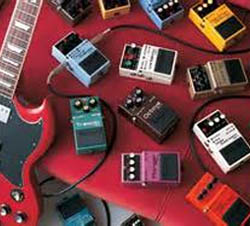Today I’m sharing something I’ve been doing a lot lately and can make mixing a lot of fun: using guitar pedals for mixing.
Plug-ins are great, but it’s just not the same as running sounds through real analog circuits. You can send sounds out of your audio interface, tweak the pedal settings and even “play” the pedal to do real-time automation. It can be a lot of fun to work this way.
For the demonstration I’ve recorded an electric guitar directly into my DAW with Amplitube for amp and cabinet simulation.
I’m going to then run the signal through an Electro-Harmonix Memory Boy analog delay pedal.
Here is the sound of the direct guitar:
Direct Guitar
Here is the guitar with the Amplitube 3 plug-in added (stereo, amp+speaker+mic):
Guitar + Amplitube
Now I’m going to run the sound through the pedal. To do this, you need an audio interface with a couple spare analog outputs; if your interface has four analog outputs, that’s perfect.
Connect a guitar cable from output 3 of the interface to the input of the pedal. Connect the ouput of the pedal to one of the instrument inputs of your interface (usually in 1 or 2). In this case, I’m going from output 5 through the Memory Boy and into input 1 of my Profire 2626.
In the DAW you need to tell the signal where to go. Most DAWs will have a plug-in for hardware inserts.
In this next example I have the hardware insert before the amp, just like if I had the pedal before the amp. When you do this remember to keep the mix control of the pedal to about 50 percent or less, you still want to have the clean guitar get through.
Hear how it sounds with the delay before the amp:
Guitar + Analog Delay Insert
There’s another way to use pedals and that’s as a separate FX track: add a new mono track to your project. You can either use the the hardware insert plug-in again and have the other tracks send to this track, or set the track to monitor the analog input and have the other tracks send to the analog output.
Here I have the guitar track sending to my delay track, which has the hardware insert plugin set the same as before. The direct guitar signal goes into amp plugin, then to the master output.
The signal from this track is also going to the delay track. It then goes into the insert plugin, out the interface, into the delay, (set to 100 percent wet, no clean sound), and then into the interface and to the same track. (I hope this makes sense.)
The benefit of doing it this way is you can blend in as much of this signal as you want. You can also use plugi-ns before and after to shape the sound independently of the original tracks. And, you can send multiple tracks in at the same time.
Here is the guitar through the delay as a send (delay after the amp in the chain):
Guitar + Delay Send
And finally, here is what the delay track sounds like soloed:
Delay Return Soloed
Pedal are inexpensive, easy to use and a lot of them really sound great on more than just guitars. Have fun!
Jon Tidey is a Producer/Engineer who runs his own studio, EPIC Sounds, and enjoys writing about audio on his blog AudioGeekZine.com.





















